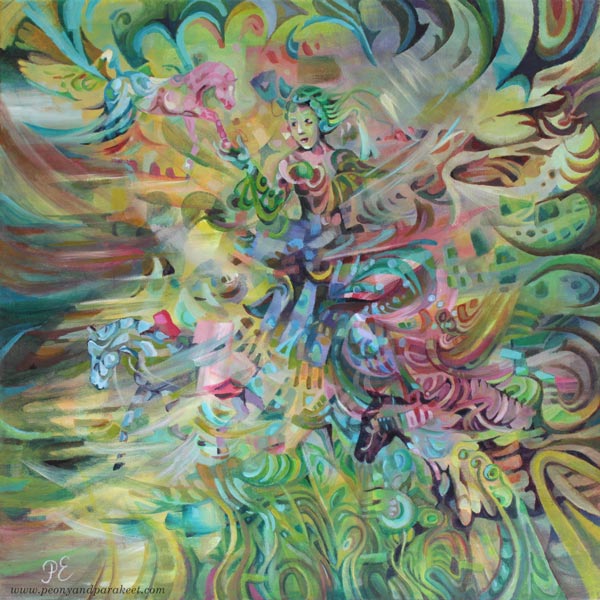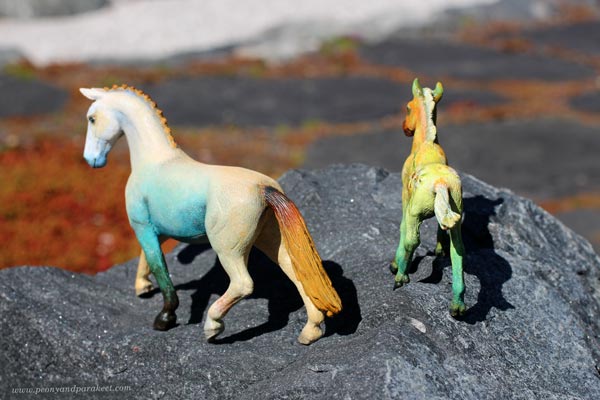How to Paint a Fantasy Horse Figurine
This week, we apply art to something different than usual. We use our skills to transform a Schleich horse or other plastic figurine into a fantasy animal.

I have a soft spot for plastic horse collectors, and I follow many of them on Instagram. One of the most inspiring accounts is Lightning Leoo (@lightningleoo). Leo has organized community challenges on Instagram and Discord. I have participated in them a couple of times. Like Leo, most of those who customize collectible miniatures aim to make the animal look more realistic. However, I want to be more playful with colors and ideas.
Step 1 – Choose a Theme and Paint the First Layer
Start by choosing a theme that gives ideas for the coloring. The animal figurine here is a brown Schleich foal and my theme is daffodil. I used acrylic paints to make the legs green, the body yellow, the hoof orange-red, and the tail and the main white – just like the flower!

At this point, the animal doesn’t look nice at all, but that’s ok. The idea is just to cover the original paint and make a simple foundation for the decoration.
Step 2 – Add More Tones and Decorations
After covering the original color with the theme colors, mix more tones of those colors. For example, if you have used one green in the previous step, now mix more green tones – cooler and warmer, darker and lighter, brighter and more muted. Add slight variations of tones on the top of the first color layer so that what used to be one solid color has now a gradient of tones. This makes the color more natural. Note: you can use this technique in any art!

In this project, I created color mixes of all kinds of greens, oranges, yellows, and whites.
At this point, you can also start decorating the figurine and use these color mixes in decorations, eyes,You and other details.

Get ideas for decorations from the theme! I painted small daffodils.
Step 3 – Optional – Add Shadows with Soft Pastels
Soft pastels make the figurine look more real and highlight the best parts. First, scrape them with a sharp blade to get color powder. Use a small brush to spread it where the shadows are, for example, where the leg meets the belly. You can also soften the color changes with pastels.

Attach the powder more permanently by spraying the fixative over it. Notice that after attaching the powder, you can continue with the finishing touches in acrylics!
Step 4 – Take a Fantastic Photo!
We always should take a good photo of the finished work, but with a fantasy horse, it is very rewarding. Find a place where you can fool the eye about the scale and bend down to take a photo a bit upwards.

Another option is to make a gallery set up so that the background is white and the figurine is photographed like a piece of art.

Another Example of a Fantasy Horse Repaint
Here’s a Schleich horse that is bigger than the Daffodil fowl. My theme for this one was peach. The decorations are simple, but there are many tones and lovely gradients.

Making one foot in a different color adds drama and a bigger horse is easier to paint.

It was fun to photograph these two together!

Natural light creates its own effects and makes the fantasy look real.

Horizontal lines in the background make the movement look more real.

Gift Box for Fantasy Horse
These small fantasy horses are great for presents. I gave the fowl to my friend who owns not just a collection of plastic figurines but a real horse too. I found a sturdy box that I had got when ordering paint tubes.

One side had writing on it, but I painted a floral decoration over it.

Creative Play as an Art Form
Playing has always been important to me. When I play, I get ideas that go beyond the ordinary and that combine different fields. In 2020, I even made a painting about the power of play called Steppe Wind.

In the course Magical Inkdom, we draw and decorate paper horses and other animals.

By playing we can enjoy the beauty and be comforted. It’s like we enter the same big hall of art but from a different door. Then when it’s time to get more serious, we have new energy and new power to overcome our fears.

That’s why I want to bring up topics like painting and photographing figurines in this blog.
What do you think?
12 thoughts on “How to Paint a Fantasy Horse Figurine”
Comments are closed.
I have to ask my great grand children if they have any “plastic” animals etc that they no longer play with….. Im hoping maybe a dinosaur – but most of these things here are rubber. You do such wonderful fantastic art thank you for sharing.
Nark
Thank you!
I just love these little fantasy horses! What a great idea and beautiful execution!
Thank you, Stephanie!
me again – why are you “scraping” because the paint does not adhere to the plastic?
and when done,, do you spray on a finish to protect the paint?
The acrylic paint does adhere to the plastic very well. I am scraping the soft pastels to get powder out of them. By spreading that powder I can make soft gradients of color on the top of the paint. The acrylic paint doesn’t need any fixative but the powder does. You can add layers of paint, then add powder and fixative, and then paint again, then add powder + fixative and thus create several layers that work together.
I love this! I am a very ‘realistic’ observational sketcher and recently found your amazing work through an artist friend. It’s fantastic, and you inspired me to try drawing from the imagination, something completely out of my comfort zone. I signed up for Magical Inkdom, and I am having so much fun! Thank you Paivi!
Thank you, Jules! Imagination always wins. I hope you will have more fun moments with Magical Inkdom.
your horses are so lovely.
your thoughts on play do seem important to explore and discover endless possibilities.
Thank you, Tammie Lee!
Love this project, you painted beautifully!
Thank you, Wendy!